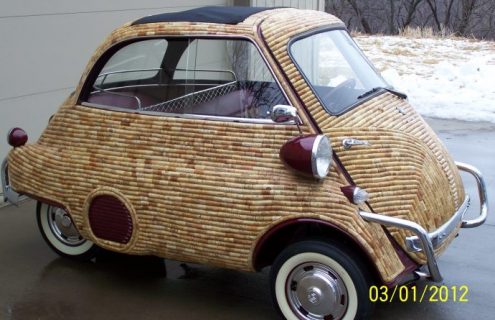BMW Isetta: A 50′s Icon
Duane Saunders, owner of Saunders Classics in Eden Prairie, MN, owned a BMW Isetta nearly 50 years ago when he was in the US Army. Back then, as a service member, one could ship a vehicle from Europe back to the US for $50. So Duane took advantage of this and shipped an Isetta home. He owned the BMW for years and learned to maintain it.
Though sold later, he never forgot it during his 40 years as a physical therapist, building a company and obtaining patents for medical devices. When it came time for him to retire and sell his company, he dove head first into finding and restoring the Isettas you see in these photos.
The BMW Isetta, interminably cute, immediately recognizable, truly is an iconic ʻ50ʻs car. There really has been nothing like it before or since in BMWʼs line-up. The whole front end actually is itʼs unique round door which opens up to access small bench seating for two. The bubble carʼs steering wheel even moves out of the way in a hinged manor to allow the driver easier ingress and egress.
Under an agreement with the Milan company Iso, BMW first produced the Isetta 250 which BMW only made for one year, 1955. BMW revised the Isetta 250 heavily and in 1956 released the Isetta 300 with an upgraded motorcycle motor. This 300cc motor took the 12 hp in the Isetta 250 up to a whopping 13 hp.
Top speed however remained unchanged at 85 km/hr or about 53 mph. The Isetta 300 came in a 3 or 4 wheeled version easily becoming the best selling Isetta model.
The Isetta 600 “limousine” was the biggest Isetta and had seating for four. BMW began production of the Isetta 600 in 1957 with a 4 wheeled version only. Seating for the rear passengers was accessible through a single door on the right, front seating was still accessed through the front of the car. Given its increased size, larger frame and weight, BMW fitted it with a 2 cylinder, 19hp motor. It was in this “limousine” that BMW first introduced itʼs independent semi-trailing arm which was subsequently used in many BMW models over the next decades. Due to the larger stable foot print and increased power the 600 had a top speed of 64mph. BMW sold around 35,000 of the Isetta 600s but was disappointed in itʼs total sales performance and stopped production in late 1959.
What is the Isettaʼs value now? It primarily depends on itʼs condition. At Barrett Jacksonʼs 2010 Auction an Isetta sold for $43,000. I asked Duane what heʼd sell his for, and he replied, “I put so much work into them by the end I just want to keep them.” Saunderʼs website www.saundersclassics.com is currently under construction as I write this.
Isetta 300
Construction time: November 1956 – April 1962 Performance: 13 bhp at 5200 rpm
Top speed: 85 km/h (53 mph)
Capacity: 298 ccm
Motortype: Single-cylinder engine, 4 stoke Sales price: DM 2,890
Units: 51,826 (plus 20,456 three wheelers) (source BMW Classic)Our own Hugo Becker not long ago wrote about the Isetta name and wondered if BMW’s i Brand might pick it up. Who knows? Perhaps with the up coming i1 they just might.
Lastly, I just had to ask what made Saunders “cork” an Isetta. “I just love cork art and one day I just started sticking them on there.” I have to say, having seen it in person in it’s burgundy wine color, it actually looks pretty good! I’d hate to get it wet though, but makes you wonder if it’d float!





Author: Chuck Vossler
Source: http://www.bmwblog.com/2012/03/11/bmw-i ... -50s-icon/








